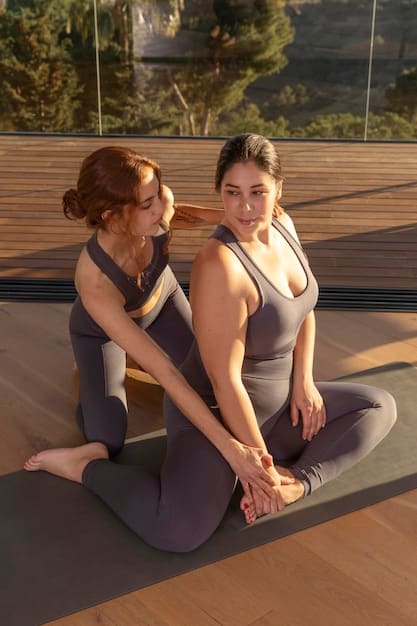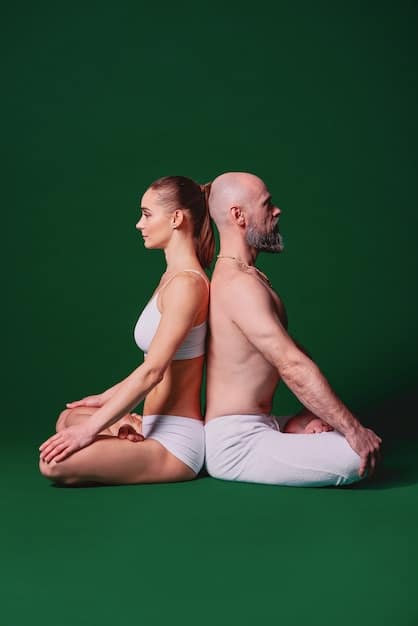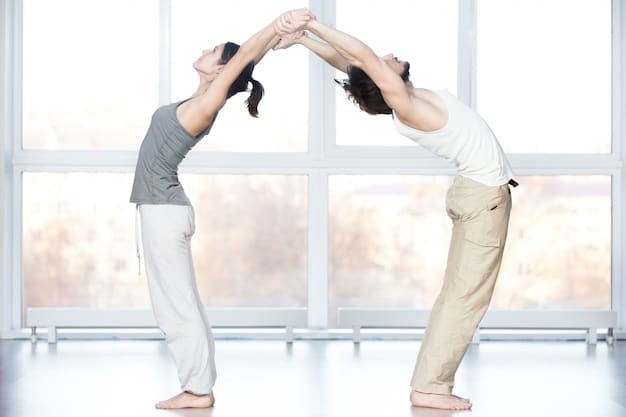Partner Yoga: Enhance Relationships & Wellness Together

Partner yoga offers a unique blend of physical and emotional benefits, fostering stronger relationships through shared practice, improved communication, and enhanced well-being for both participants.
Discover the transformative power of partner yoga, a practice that transcends individual asanas to weave stronger relationships through shared movement and mindful connection. The benefits of partner yoga: strengthening relationships through shared practice are profound, affecting both physical and emotional well-being.
Understanding Partner Yoga: A Collaborative Practice
Partner yoga, also known as couples yoga or relationship yoga, involves two individuals working together to enhance traditional yoga poses. This collaborative approach not only deepens the physical experience but also cultivates trust, communication, and a sense of unity between partners.
Unlike individual yoga, partner yoga encourages practitioners to support, assist, and challenge each other, creating a dynamic and engaging practice. This shared journey fosters a deeper understanding and appreciation for one another.
The Essence of Connection in Partner Yoga
At its core, partner yoga is about fostering connection and communication. Each pose requires active listening, non-verbal cues, and a willingness to support your partner, both physically and emotionally.
How Partner Yoga Differs from Solo Practice
While solo yoga focuses on individual alignment and introspection, partner yoga emphasizes teamwork and mutual support. This shift in focus can lead to a more playful and engaging practice, offering new perspectives on familiar poses.
- Enhanced Communication: Verbal and non-verbal communication are essential.
- Mutual Trust: Builds a sense of trust and reliance.
- Deeper Stretches: Facilitates deeper, supported stretches.
- Shared Experience: Creates a unique bonding experience.
In essence, partner yoga offers a pathway to greater physical and emotional well-being while simultaneously strengthening the bonds we share with those we care about. It’s more than just exercise; it’s a practice in mindfulness, communication, and connection.
Physical Benefits: Enhanced Flexibility and Strength
The physical advantages of partner yoga extend beyond those of a solitary practice. The added support and resistance from a partner can facilitate a deeper range of motion, improve balance, and enhance overall strength.
This collaborative approach allows individuals to safely explore more challenging poses, guided by the presence and assistance of their partner. The shared effort fosters a sense of accomplishment and mutual encouragement.

Increased Range of Motion
Partner yoga can help individuals achieve a greater range of motion by providing gentle, guided assistance during stretches. This support allows for deeper exploration of poses, promoting flexibility and joint health.
Improved Balance and Stability
Many partner yoga poses require a shared sense of balance and stability. Working together to maintain equilibrium not only enhances individual balance but also fosters a collective sense of stability and coordination.
- Deeper Muscle Engagement: Partner resistance increases muscle activation.
- Enhanced Proprioception: Heightened awareness of body positioning.
- Joint Mobility: Gentle assistance promotes joint flexibility.
- Improved Posture: Supported alignment enhances posture.
Through consistent practice, partner yoga can lead to tangible improvements in physical fitness, fostering a greater sense of body awareness and overall well-being. The shared journey encourages individuals to push their boundaries in a safe and supportive environment.
Emotional Benefits: Building Trust and Intimacy
Beyond the physical advantages, partner yoga offers profound emotional benefits, fostering trust, intimacy, and a deeper sense of connection between participants. The shared experience creates a safe space for vulnerability and authentic expression.
Engaging in partner yoga requires open communication, active listening, and a willingness to support your partner’s emotional needs. This collaborative approach strengthens emotional bonds and cultivates a greater sense of empathy.
Cultivating Trust and Vulnerability
Many partner yoga poses require a significant level of trust and vulnerability. Supporting each other through challenging stretches builds a sense of reliance and mutual respect, fostering a deeper emotional connection.
Enhancing Communication and Empathy
Effective communication is essential in partner yoga. Learning to listen actively, express your needs clearly, and respond with empathy strengthens both verbal and non-verbal communication skills, leading to healthier relationships.

- Reduced Stress: Shared relaxation lowers stress levels.
- Increased Affection: Physical touch enhances intimacy.
- Emotional Support: Partners provide mutual encouragement.
- Shared Joy: Laughter and playfulness strengthen bonds.
By prioritizing emotional connection alongside physical alignment, partner yoga offers a holistic approach to wellness, fostering stronger, more resilient relationships. The shared journey encourages individuals to explore their emotional boundaries in a supportive and compassionate environment.
Improving Communication: Verbal and Non-Verbal Cues
Effective communication is the cornerstone of partner yoga, requiring participants to develop both verbal and non-verbal cues to navigate the practice harmoniously. Clear and concise communication ensures safety, fosters trust, and deepens the connection between partners.
Learning to listen actively, express your needs clearly, and respond with empathy are essential skills that extend beyond the yoga mat, enriching all aspects of your relationships. The shared experience cultivates a greater sense of understanding and mutual respect.
Active Listening and Empathetic Response
In partner yoga, active listening involves paying close attention to your partner’s verbal and non-verbal cues. Responding with empathy demonstrates understanding and support, fostering a deeper sense of connection.
Developing Clear and Concise Verbal Cues
Clear and concise verbal cues are essential for guiding your partner through poses safely and effectively. Using simple language and avoiding ambiguity ensures that both partners are on the same page.
During partner yoga, you and your partner will learn to rely on verbal and non-verbal cues, which can strengthen:
- Clarity in Expression: Expressing needs and limitations effectively.
- Non-Verbal Awareness: Recognizing subtle cues and body language.
- Collaborative Problem-Solving: Working together to overcome challenges.
- Conflict Resolution: Navigating disagreements with respect and understanding.
By honing these communication skills, partner yoga enhances not only the physical practice but also the emotional well-being of both participants. The shared journey fosters a greater sense of intimacy, trust, and mutual support.
Who Can Benefit: Suitable Partners and Considerations
While partner yoga is often associated with romantic couples, its benefits extend to a wide range of relationships, including friends, family members, and even colleagues. The key is to find a partner with whom you feel comfortable and safe, and who shares a mutual interest in exploring the practice.
Before embarking on partner yoga, it’s essential to consider individual fitness levels, physical limitations, and any pre-existing conditions. Adapting poses to suit individual needs ensures a safe and enjoyable experience for all participants.
Friends and Family Members
Partner yoga can be a wonderful way to deepen connections with friends and family members. Sharing a physical activity fosters a sense of camaraderie and mutual support, creating lasting memories and strengthening bonds.
Romantic Couples
For romantic couples, partner yoga offers a unique opportunity to enhance intimacy, communication, and trust. The shared experience cultivates a deeper understanding and appreciation for one another, strengthening the foundations of the relationship.
- Age and Fitness Level: Adapt poses to accommodate different levels.
- Physical Limitations: Modify poses to avoid strain or injury.
- Comfort Level: Choose a partner with whom you feel safe and comfortable.
- Shared Intentions: Align your goals for the practice.
Regardless of the relationship dynamic, partner yoga offers a transformative experience for those seeking to enhance their physical, emotional, and relational well-being. By prioritizing safety, communication, and mutual respect, participants can unlock the full potential of this collaborative practice.
Getting Started: Tips and Basic Poses
Embarking on your partner yoga journey can be an exciting and rewarding experience. Start by finding a qualified instructor who can guide you through the basics and ensure proper alignment. Alternatively, explore online resources and beginner-friendly tutorials to learn fundamental poses.
Remember to communicate openly with your partner, listen to your bodies, and adapt poses as needed. Prioritize safety and comfort above all else, and embrace the opportunity to explore new dimensions of your physical and emotional connection.
Finding a Qualified Instructor
A certified yoga instructor with experience in partner yoga can provide valuable guidance, ensuring proper alignment and preventing injuries. Look for instructors who prioritize safety, communication, and individual needs.
Basic Partner Yoga Poses for Beginners
Start with simple poses that require minimal flexibility and balance, such as seated twists, supported backbends, and standing forward folds. These poses provide a gentle introduction to partner yoga, fostering trust and communication.
- Seated Twist: Enhances spinal mobility and promotes relaxation.
- Supported Backbend: Opens the chest and invigorates the body.
- Standing Forward Fold: Stretches the hamstrings and calms the mind.
- Partner Breathing: Synchronizes breath and cultivates connection.
With patience, practice, and open communication, you and your partner can unlock the transformative benefits of partner yoga, fostering stronger relationships and enhanced well-being. The shared journey is an opportunity to deepen your connection, cultivate trust, and explore new dimensions of your physical and emotional landscape.
| Key Aspect | Brief Description |
|---|---|
| 🤝 Strengthened Bonds | Enhances trust and intimacy between partners. |
| 💪 Physical Benefits | Improves flexibility, balance, and strength with support. |
| 🗣️ Communication | Cultivates clear verbal and non-verbal communication skills. |
| 🧘 Shared Well-being | Promotes relaxation, reduces stress, and enhances overall well-being. |
FAQ
▼
The main goal is to deepen relationships through shared movement, building trust, communication, and mutual support while enhancing physical and emotional well-being for both partners.
▼
It’s suitable for friends, family members, and romantic couples seeking to enhance their connection. Adaptations can accommodate different fitness levels and physical limitations, ensuring a safe experience.
▼
Begin with poses like seated twists, supported backbends, and standing forward folds. These are gentle, foster trust, and allow partners to synchronize movement and breath comfortably.
▼
It enhances communication by requiring partners to listen actively, express their needs clearly, and respond with empathy. Verbal and non-verbal cues become essential for navigating poses and supporting each other.
▼
Emotional benefits include increased trust, vulnerability, intimacy, and empathy. The shared experience provides a safe space for emotional expression, fostering deeper connections and stronger, more resilient relationships.
Conclusion
Embracing the practice of partner yoga opens doors to enhanced physical well-being, deeper emotional connections, and improved communication skills. Whether you’re seeking to strengthen a romantic relationship, connect with a friend, or simply explore new dimensions of your yoga practice, partner yoga offers a unique and rewarding journey towards holistic wellness and shared growth.





